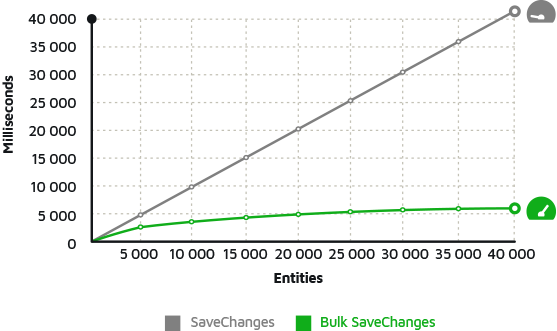Entity Framework DetectChanges Discover How to Improve Performance
How to Improve Entity Framework DetectChanges Performance?
When you track multiple entities in your context, then your application will suffer from performance issues caused by the Entity Framework DetectChanges method.
using (var ctx = new CustomerContext()) { foreach(var line in lines) { var customer = new Customer(); // ...code... // DetectChanges is invoked every time you call Add ctx.Customers.Add(customer); } ctx.SaveChanges(); }
StackOverflow Related Questions
Answer
- REDUCE the amount of entities in your context
- REDUCE the number of DetectChanges
- SET AutoDetectChanges to false
REDUCE the number of entities in your context
When adding/modifying multiple entities, split your logic into numerous batches to have fewer records in the context.
Why?
The more tracked entities your context contains, the slower the DetectChanges method is!
Performance Comparisons
| Operations | 100 Entities | 1,000 Entities | 10,000 Entities |
|---|---|---|---|
| Unlimited | 15 ms | 1,050 ms | 105,000 ms |
| 10 | 3 ms | 40 ms | 350 ms |
| 100 | 15 ms | 125 ms | 1,200 ms |
| 1,000 | 15 ms | 1,050 ms | 10,200 ms |
Note:
- *: SaveChanges time not included
- **: Entity with two relations
How?
- CREATE batchSize variable
- CALL SaveChanges before creating a new batch
- CALL SaveChanges
- Done!
// 1. CREATE a batchSize variable int batchSize = 400; var context = new EntityContext(); for(int i = 0; i <= 2000; i++) { // 2. CALL SaveChanges before creating a new batch if (i != 0 && i%batchSize == 0) { context.SaveChanges(); context = new EntityContext(); } var customer = new Customer(); // ...code... context.Customers.Add(customer); } // 3. CALL SaveChanges context.SaveChanges(); // 4. Done!
Reduce the number of DetectChanges
When adding multiple entities, you should always use Entity Framework AddRange once with a list instead of calling the Add method multiple times.
Why?
- The Add method DetectChanges after every record added.
- The AddRange method DetectChanges after all records are added.
Performance Comparisons
| Operations | 100 Entities | 1,000 Entities | 10,000 Entities |
|---|---|---|---|
| Add | 15 ms | 1,050 ms | 105,000 ms |
| AddRange | 1 ms | 10 ms | 120 ms |
Note:
- *: SaveChanges time not included
- **: Entity with two relations
How?
- CREATE a list
- ADD entity to the list
- USE AddRange with the list
- SaveChanges
- Done!
using (var context = new EntityContext()) { // 1. CREATE a list List<Customer> list = new List<Customer>(); for(int i = 0; i < 2000; i++) { var customer = new Customer(); // ...code... // 2. ADD entity to the list list.Add(customer); } // 3. USE AddRange with the list context.Customers.AddRange(list); // 4. SaveChanges context.SaveChanges(); // 5. Done! }
SET AutoDetectChangesEnabled to false
When adding multiple entities, if you cannot use AddRange, set Entity Framework AutoDetectChangesEnabled to false
Why?
- The Add method DetectChanges after every record added.
By disabling AutoDetectChangesEnabled, the DetectChanges method will only be invoked when you do it.
Performance Comparisons
| Operations | 100 Entities | 1,000 Entities | 10,000 Entities |
|---|---|---|---|
| True (Default) | 15 ms | 1,050 ms | 105,000 ms |
| False | 1 ms | 14 ms | 180 ms |
Note:
- *: SaveChanges time not included
- **: Entity with two relations
How?
- SET AutoDetectChangesEnabled = false
- CALL DetectChanges before SaveChanges
- SaveChanges
- Done!
using (var context = new EntityContext()) { // 1. SET AutoDetectChangesEnabled = false context.Configuration.AutoDetectChangesEnabled = false; List<Customer> list = new List<Customer>(); for(int i = 0; i < 2000; i++) { var customer = new Customer(); // ...code... list.Add(customer); } context.Customers.AddRange(list); // 2. CALL DetectChanges before SaveChanges context.ChangeTracker.DetectChanges(); // 3. SaveChanges context.SaveChanges(); // 4. Done! }
ZZZ Projects
